Courtesy of Ray Piercy (aka "Shearjoy" of Canadian Canoe Routes)
(planned route: Opeongo, Merchant, Longer, Catfish rapids, Hogan, Big Crow, Lavieille, Animoosh, Farm, Annie Bay)
This trip was planned as a leisurely solitude retreat and paddling meditation experience. The plan was to go only a short distance each day and paddle slowly close to the lea shore of the lakes going into and out of all the bays. This is of course the safest course when the water is cold, but I hoped it would also enhance the peace and tranquility aspect.
There were a lot of “firsts” for me on this trip. It was my first extended solo trip, having only done one three day solo a couple of years ago. It was my first trip in Algonquin late in the year, since I have usually tripped in May. It was my first time on the big lakes in the central part of the park. It was the maiden voyage for my solo canoe (a Shearwater), I had a new tent , new sleeping bag and new food menus based on reading suggestions in the online forums. It was also my first trip carrying a stove rather than cooking on a fire and my first taking two carries on the portages. It was my first time carrying pepper spray and a Spot messaging system.
Day One
I got off to a late start, leaving the Opeongo dock at 4:30 on Saturday October 18. I cruised up the relatively calm lake to the start of the north east arm in 1.5 hours. I loved the efficiency of the solo boat. A relatively warm 4 degrees meant I could comfortably write in my journal and read after going to bed early.
The long hours of darkness, about 12, was new to me since in May there is more light. I found that I fell into a pattern of getting into the tent about 7:30 and usually had lights out by 8:30 because it was cold enough by then to need my shoulders to be inside the sleeping bag. Tired from the day, I immediately fell asleep but then woke about 2:00 am and lay awake for several hours before falling asleep again for a couple of hours before getting up at first light (7:00am). Apparently this is a common sleep pattern from northern countries in the days before oil and electric lights. Their old journals refer to a “first sleep” and a “second sleep”. It worked well for me for the entire trip. I always felt well rested in the morning.
Day Two
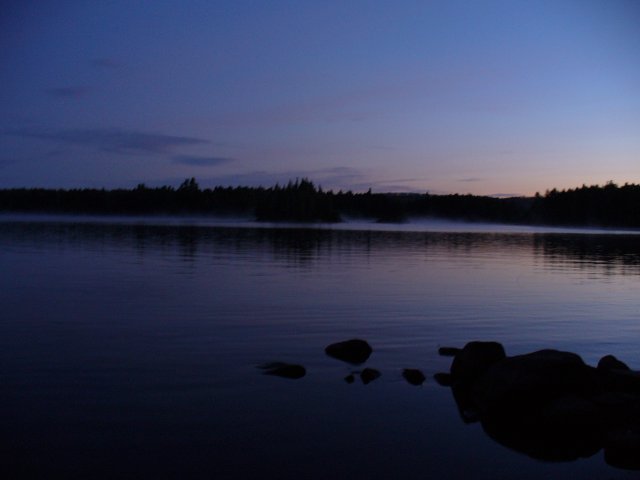
Opeongo Morning
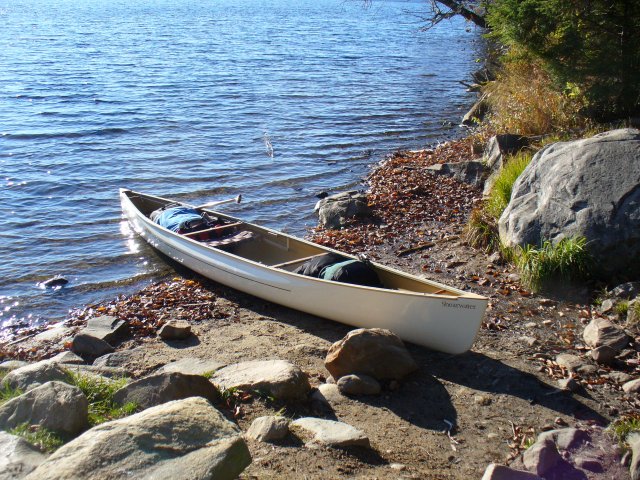
The second day I went as far as Merchant Lake as planned. The quiet paddling close to shore worked very well for meditation. In the early days of the trip I found that I could only work at about 30% of maximum sustainable effort and still maintain a meditative awareness. More effort drove any conscious awareness of who I was or what I was doing out of my mind. As the trip went on I got slowly better at meditating while making stronger physical effort, up to about 70% effort by the end. This was enough to allow portaging to be a meditative walk in the woods, except on very rough or steep trails.
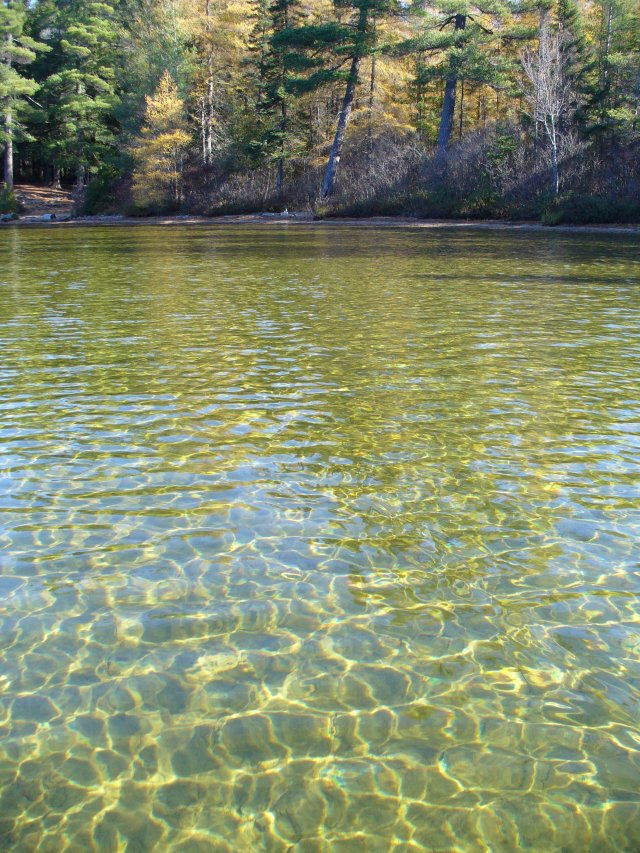
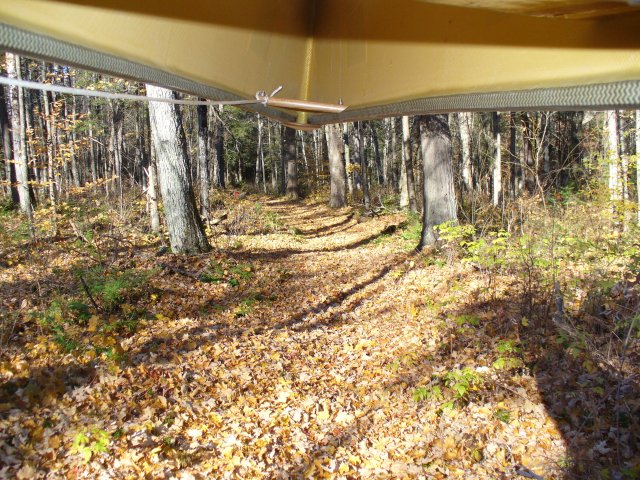
Under the canoe.
I found the leapfrog method of portaging two carries very effective, since I could always get back in the meditation groove during the return portion with no packs. I stopped early enough this night to get wood for a campfire. On my previous solo trip I had minor trouble with fear of the dark and “bear fever”. This trip I had no problems with these anxieties. I put it down to having the pepper spray on my hip in a holster at all times. Although I have never seen a bear on a canoe trip the spray is a great security blanket.
Day Three
The third day, ending at the south part of Burnt Root Lake, was much like the second, although the nice sunny weather changed to rain. I noticed a difference in my attitude toward rain and wind on this trip compared to previous trips, which I attribute to the meditation. I found I could respond much more emotionally evenly to the “good” and the “bad” weather. It just did not affect what I was doing that much. I was struggling much more with the distractions of the “inner dialogues” which fill my head when I try to meditate than I was with the distractions of weather. Over the trip I identified two main voices in these dialogues, “the explainer” and “the planner”. I would find myself talking out loud explaining things to myself, even the same things several times a day. A certain amount of planning is necessary on a canoe “retreat”, such as how far will I get today, when should I stop etc., but the “planner voice” wanted to do much more than was necessary.
This day I stopped late, about 6:00, and made a quick camp, really appreciating having a stove and not needing to find wood and make a fire in the rain. I have had the stove for years for hiking and I now cannot believe I have never used it canoeing. I loved how fast I could get hot food into me even if I was dead tired and the light was fading. The one pot meals, based on rice or pasta, dried veggie flakes, dehydrated hamburger or chicken flakes and a powdered sauce mix were very impressive (if I do say so myself). Soaking them for a few hours before stopping for the night meant that they really just needed to be heated which took all of five minutes. Over the trip I used less than half of the fuel that I had brought along (used 0.9 litres of white gas).
Day Four
Over night I'd heard rain on the tent fly whenever I was awake. By 6:00 am I could no longer hear it and I got up anticipating a clear day. It was a shock to see that the noise had stopped because the rain had turned to snow and the wind was picking up. As I broke camp it was still quite warm (+4) but as I paddled the first section up into the lake the wind increased and the horizontal snow was stinging my face. Fearing frostbite I hauled out my winter fleece hat which has a long tube which can be folded up inside to cover my mouth and nose. Warm and dry I paddled around the corner into the main body of the lake.
The wind was strong, the snow was heavy and wet, the waves were large. I struggled along the south shore appreciative of the stability of my canoe. Even when the snow flakes stung my eyes and I had to close them, I did not have to worry about when my paddle was in or out of the water to stabilize the boat. It bobbed about happily without any action on my part. I made it to the partially sheltered western shore and struggled up the lake around the various headlands for about four hours. The whiteouts were so bad that navigation was difficult. I could rarely see the islands in the middle of the lake and never the far shore, and it is not a wide lake.

Paddling in a blizzard was one of the many “firsts” for me on this trip. When I arrived at the lea north shore the front of my life jacket was covered with about 2 inches of frozen snow and ice. I paddled slowly across to the east side for the portage. This was a mistake. I was dressed for the more intense effort of paddling upwind and the temperature had dropped to zero. Getting out of the canoe I began shivering uncontrollably and I had trouble with mental focus when working with the snaps on my raingear. I recognized the early signs of hypothermia and wondered if I had the skills and the gear to survive this. It was the lowest emotional moment of the trip.
I hauled two wool sweaters out of my pack and dry wool mitts with leather over mitts. The short portage warmed me somewhat, but I did not really get warm until after the next lake when there were several portages in a row. By then I was feeling better and confident again. The snow tapered off to flurries and I was in the sheltered river valley (the Petawawa) out of the wind. It was incredibly beautiful to paddle down the winding river and see around every corner a new vista of trees laden with snow.

There was a slight problem at the put ins that fortunately I noticed just in time. The shallow beaches that the canoe can just be pulled up on, when covered in snow become a gentle slope for the “shearsnow toboggan”. The boat can pick up a surprising amount of speed in a very short distance and end up sliding into the lake while you are not looking.

I think the beauty lulled me into a sense of complacency for I then made a fundamental mistake that I have made several times on previous trips and should have known better. Since I was following a river and the portages are well marked and just lead to the river again, I stopped keeping track of where I was on the map. I came to a portage and hardly looking at the sign, I shouldered my pack and plunged into the knee deep snow. About 300m into the portage my sense of direction, which is usually very good, told me that the trail was not turning to follow the river. But my sense of direction has been fooled before in snowy woods while bush-whacking on snow shoes, so I decided I could not trust it. When I got to the end of the 1000m I was at a lake, not the river. Finally I checked the map and realized that there was a portage that I did not want to take that lead away from the river on another route.
Fortunately I had the time in my plan for the day and the strength and physical energy that this was just an unexpected pleasant walk through beautiful snowy woods. But in other circumstances this could have been a serious error and I really need to remember the lesson I have learned several times: know where you are on the map at all times. I stopped at a campsite at Catfish rapids for nostalgia. It was the site that my father took me to on my very first canoe trip about 40 years ago.
Day Five
The temperature had dropped to -4 overnight (+1 in the tent) and when I woke up the knots in the ropes holding the food pack in the air were frozen solid. I had a pair of needle nose pliers in my kit (a habit left over from days long ago when my canoe trips were fishing trips) which proved very useful for the first time in many years. My feet were often cold on this trip (rubber boots a size too big with two pairs of wool socks). They were warm while portaging and working around camp but I could only paddle a couple of hours before stopping to walk around to warm them up. Since I was camped at the end of an 800m portage, I walked it once when I first woke up to warm up my feet (in damp wool socks) and then again just before I began to paddle again. This tactic worked well.
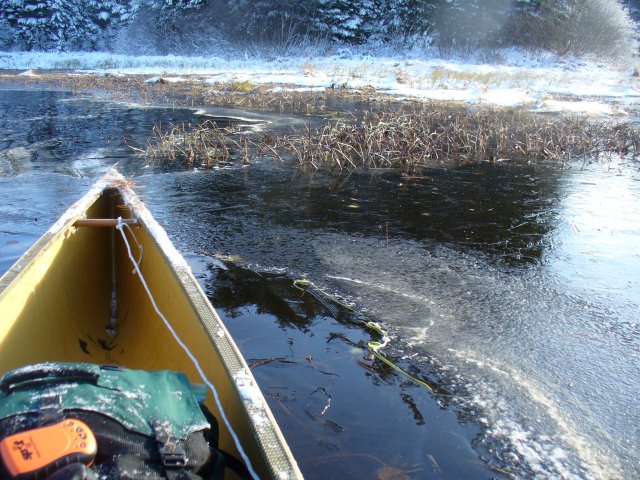
Edge of the ice.
My trip plan was to head south up the creek to Sunfish lake and on to Hogan, but as soon as I approached the marsh in which the creek ends at the Petawawa river I found that it was frozen. Not just a thin skin of ice but enough to run the canoe up on and not break through. I waited around for an hour to see if the bright sun would melt it but it did not. I decided to change my route and go back up the Petawawa, through Burnt Root and on Lake la Muir and hence to Hogan. It was a great day in the sunshine and snow, with a high of +4C. I camped on the east end of Lake la Muir as darkness was coming on. Even at +1, in the sun with no wind I felt warm enough to have a sponge bath and wash my hair (the little I have).
Day Six
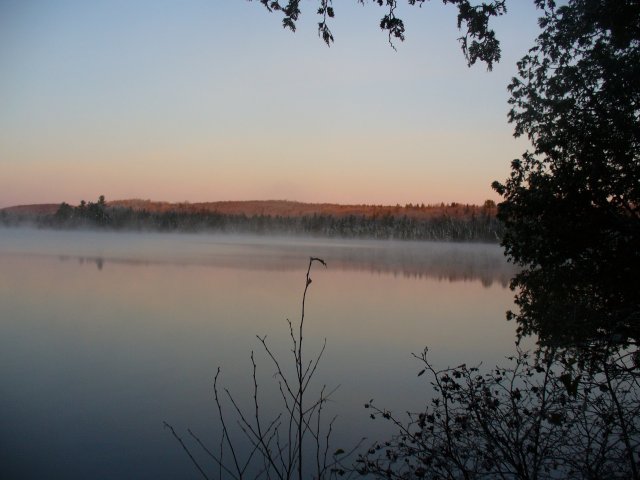
Lake La Muir at 7 am.
I woke to temperatures of -7C which was -2 in the tent so my water bottles froze. Does any one know if it is still necessary to treat water at these temperatures? I assumed it was since cysts would survive the freeze and revive in my stomach, but it was awkward to keep water bottles from freezing. I had not brought a wineskin.
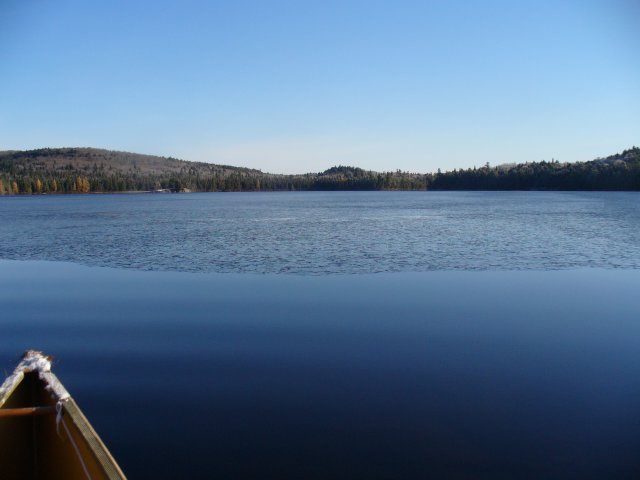
Paddling around the point into the final eastern bay of the lake I again was stopped by ice. This time it was a thin skin of ice that broke fairly easily, but it filled the entire eastern bay of the lake. Although I could paddle through it, I was worried about the possible damage to the bow of my canoe after a kilometer or two and it was difficult to change direction. I began to be worried that if the cold weather continued, and the bays began to freeze, that I might not be able to paddle out. I checked the map and decided that I would take the overland route back to Opeongo (via Deeryard Lake to Merchant) because Opeongo would certainly not freeze for a long time and this route would avoid small creeks. The portages to Merchant Lake were rough and hilly. I lost my focus on meditation for much of this day. The weather was sunny with a high of +5.
Day Seven
The seventh day, as I was completing the portage into Opeongo, I met another solo canoeist also heading out to Opeongo. He had spent the blizzard climbing over beaver dams on the Tim River and yesterday morning smashing his way through the ice up Big Trout Creek. I was glad I had chosen the overland route. With the weather improving I decided to go to Proulx Lake and check out the Crow River. I would stay on Proulx over night and if there was no ice on the river in the morning return to my original route. I was relaxed enough this day to return to my paddling meditations.
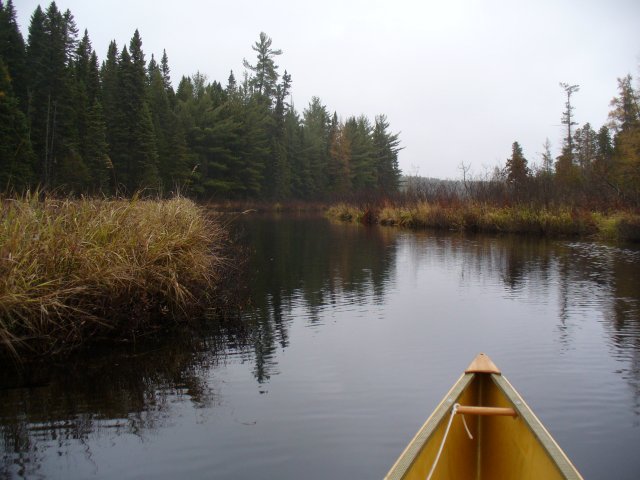
Testing the Crow River.
Day Eight
The next day dawned warmer (+8) but raining. The Crow River was free of ice so I proceeded down to Lavieille. It was probably the most enjoyable day of the trip. I loved paddling the solo canoe down the winding Crow River.

I was amazed by the number and variety of wildlife I saw on this trip, 4 moose (on three occasions), 16 otters (on 6 occasions), beaver, muskrat, and mink (which was a first for me and I may not have identified them correctly). The animals were probably more visible because the park was less crowded. There would not have been a canoe down the river an hour before me like there would have been in more popular times.

Day Nine
The rain and warmth continued the next day. Although there was a strong wind I managed to avoid it on Lavieille by hugging the west shore.
At noon when I arrived at Dickson Lake the wind had shifted to the south and it was a battle to get up the bay from the portage. As I struggled, I thought I smelled smoke and later saw the smoke coming from the first island, which has a campsite. I assumed it was someone trying to keep warm but then I saw flames through the trees that were about three feet high and over an area of at least 6 feet, too big for a camp fire.
I paddled up to investigate and found a large log burning in the middle of a burnt out area of irregular shape but about 20 feet by 40 feet. The fire was spreading through the peat layer about two inches below the pine needle forest floor, fanned by the strong wind. I got out my collapsible bucket but I found that the upper layers of pine needles protected the peat layer from the water. By using a digging stick (I don’t pack a shovel) I managed to remove the upper layer from all parts that were smoking and put out the smoldering peat with water. I worked for 2.5 hours, I estimate 120 buckets of water, and there was no smoke when I left but without shovels and axes I cannot be sure it was out. I reported it as soon as I got out to a phone. I imagine it was started by someone who wanting to avoid the cold wind days before had started a fire on the sheltered side of a hill rather than in the fire circle that was exposed to the wind. On 4 inches of snow I am sure it felt safe, but the fire melts the snow, dries the pine needles and sets the peat on fire. When the fire is doused with water the surface fire goes out but the peat, protected under the top layers, continues to smolder.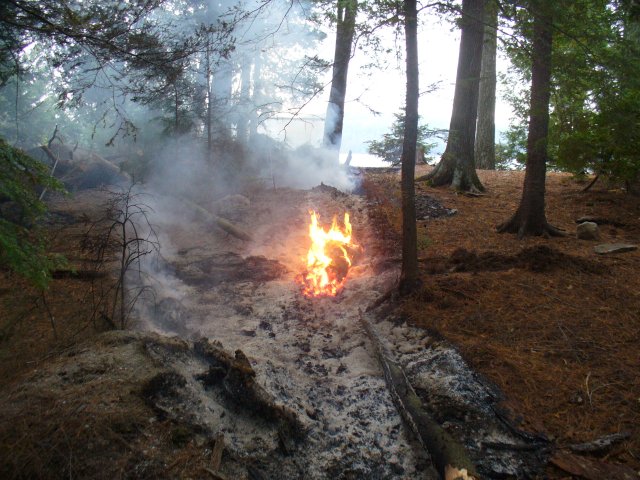
Undergound wild-fire

This diversion made me a bit late on the portage into Animoosh. In the dying light and rain it is a gloomy forest, a cedar/spruce bog, with branches weighed down with moss and lichen. I felt like a hobbit entering a forbidden place. I had not put on my raingear this day because I wanted to try a nylon jacket and letting my legs get wet, knowing that they would dry out from my body heat after a rain shower stopped. This had worked well all morning during showers, but it had poured steadily from mid afternoon until I camped. This meant that every article of clothing that I had on as I went to bed could have water wrung out of it holding it out the tent door. It took some fortitude to put on all the wet wool the next morning at +1 in the tent, but I was amazed at how fast I warmed it up. Wool is amazing in the cold and wet.
Days Ten & Eleven
The next two days were rather uneventful. The temperatures dropped again and the rain turned to snow. The high winds continued. The bog changed to great pine forests and then to birch groves. The portage trails got better and better until they were essentially roads.

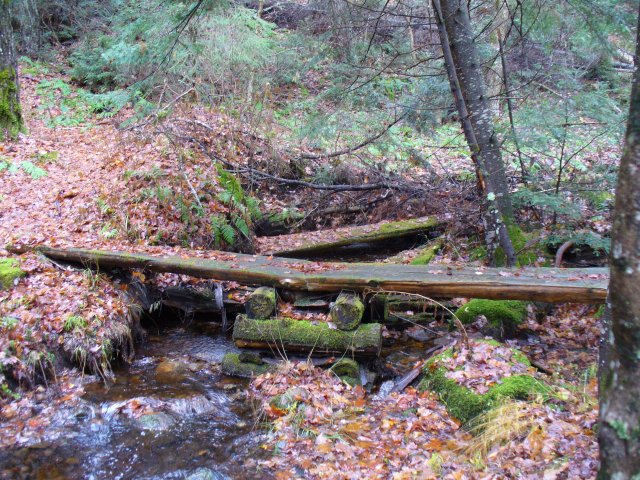
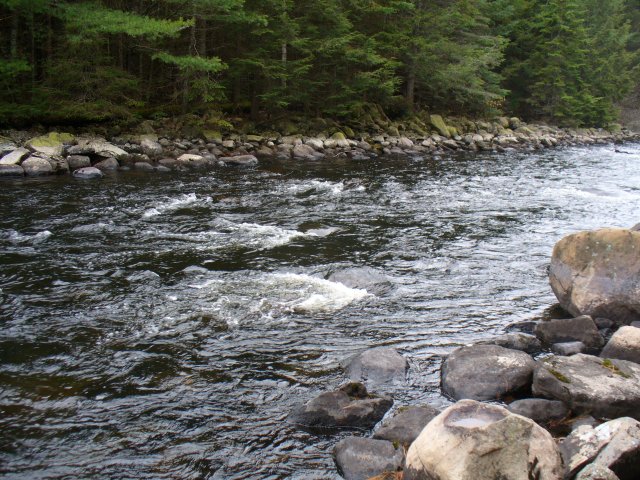
Opeongo River
My clothes dried out as the snow flurries relented. I learned that the best way to dry wool socks was to wear them on my hands as mitts as I paddled. In the boots the moisture had no where to go. Then I put the dry socks on my feet and the wet ones from my feet on my hands to repeat the process. As I made my way up Booth Lake against a fierce wind, I realized that I was not going to make Annie Bay before dark, so I stopped early at the west end of Booth.
Day Twelve
The morning was -4 and snowing with a strong wind that had blown hard all night. As I was on a portage up the Opeongo River I saw a helicopter fly down the valley. After paddling up Annie Bay on the lea eastern shore, I met with 1 to 2 foot waves on the eastern arm of Opeongo. I tried the southern shore but decided after about 1 km that it was too risky even staying 20 feet from shore. It was very cold with the waves freezing onto the rocks.I turned back to try the north shore and as I paddled up the east end of the lake an OPP helicopter passed over me coming from the south west, turned over the trees to the east of me and then returned from the direction it had come. I thought this was strange, to see two helicopters in the same day. About 30 minutes later a motor boat approached me across the bay, moving slowly because of the large waves. It turned out to be an OPP boat with one officer and a park warden. They asked me who I was and if I owned the car in the parking lot at Opeongo access. I said I did and the warden asked me if I knew I was a day overdue. I replied that I thought I had until tonight to get out, but on checking my permit it appears that I had miscounted the days when I had changed my route because of the ice.
The first helicopter had been the park personnel looking for me, but they had not seen me through the trees on the portage. The park staff had called in the OPP search and rescue unit. They would not normally do this for someone just a day overdue, but they were concerned because of the weather (windchill -10) and not finding me as they would have if I had just been wind bound on Annie Bay. They offered me a lift back to the access point. On the way back I apologized for bringing them out on such a bad day. They had to stand to drive the boat in order to see over the windshield which was coated with ice from the spray. The OPP officer kindly said “Don’t worry about it. It’s what we do.
As we went across the lake another OPP boat approached with three officers in it and asked if medical assistance was required. I began to feel even more embarrassed. They had been patrolling the shoreline looking for an overturned canoe and a body. When we got to the dock there were four OPP vehicles and an ambulance waiting. When I had unloaded my packs and boat, the paramedic said she needed to interview me. Inside the ambulance it became apparent that I was fine. She suggested that I could refuse evaluation so she did not have to take all my vital signs and do the paper work. She radioed to cancel a second ambulance that had been dispatched because they had a report that I had been found in the water and the second ambulance had specialized hypothermia gear.
After leaving the ambulance I went and retrieved my car, but before I got my gear loaded an OPP officer asked if I would follow him up to one of the buildings to answer a few questions. In the building, in a large room like a cafeteria, they had set up the command post for the search. There were another three OPP officers, two parks staff and two support staff, one in charge of communications (with a radio telephone etc.) and one in charge of food and hot drinks. There were plates of sandwiches, veggies and fruit under plastic covers. It reminded me of my daughters wedding reception a few weeks earlier. On a table they had spread out a map of the park with my route marked in black magic marker and circles on each night’s planned stay.
They asked about my route and where I had deviated from it and why, since this is the type of thing they are guessing at in their search. When they heard about the ice they turned to each other and said “we hadn’t thought of that”. At least they learned something, but it was still felt bad to have caused all this trouble. They told me they had left two messages on my home phone saying that they were looking for me and asking my family to contact them. Fortunately no one was home during the day to pick up the messages and so no one panicked. Not that they should have panicked because the Spot messenger worked perfectly so my family got “I’m OK” messages every noon and night. Unlike my satellite internet service the Spot seems to work in snow and rain storms, although I had not tried at the height of the blizzard. If someone had been home to pick up the messages they could have told the OPP where I was. I had been expecting to end my meditative solitude retreat by paddling quietly to my car and driving away alone. It was not to be.
Overall it was a good trip. I had the solitude retreat experience I wanted (seeing only the one soloist and one tandem in 11 days), I learned something about myself and developed more trust in my clothing and gear. But I might try this in September next year.